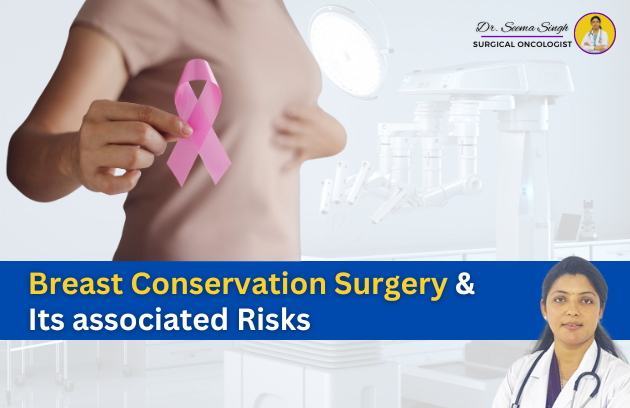- January 31, 2024
- Dr Seema Singh
- Comment: 0
- Uncategorized
What is Breast Conservation Surgery?
During Breast Conserving Surgery (BCS), only the portion of the breast affected by cancer is removed. This typically involves excising the cancerous lump along with a margin of surrounding breast tissue. The extent of tissue removal depends on factors such as the size and location of the tumour.
Additionally, as part of the procedure, the surgeon may remove some of the lymph nodes located under the arm to assess whether the cancer has spread to these areas. This is because breast cancer commonly metastasizes to the nearby lymph nodes, which can serve as a pathway for further spread to other parts of the body.
Following BCS, radiation therapy is often administered to target any remaining cancer cells that may not have been eliminated during surgery. In certain cases, chemotherapy may also be recommended in conjunction with radiation therapy to provide comprehensive treatment and reduce the risk of cancer recurrence.
Risks of Breast Conserving-Surgery:
Breast-conserving surgery, like any surgical procedure, carries certain risks. Some potential complications of BCS include:
- Temporary breast swelling in the short term.
- Alterations in the size and shape of the breast.
- Formation of scar tissue leading to hardness at the incision site.
- Risk of wound infection or bleeding.
- Swelling of the arm (lymphedema) if lymph nodes were removed.
- Presence of clear fluid in the wound post-surgery, which may require drainage and compression therapy if necessary.
It’s important to note that individual medical conditions can introduce additional risks. Therefore, it’s crucial to address any concerns with your doctor before undergoing the surgery.
How to prepare for Breast Conserving- Surgery:
- Preparation: You’ll be asked to change into a gown, and an intravenous (IV) line may be inserted into your arm or hand for administering fluids and medications.
- Positioning: You’ll lie on your back on the operating table.
- Anaesthesia: BCS can be performed under local anaesthesia with sedation or general anaesthesia. With local anaesthesia, the surgical area is numbed, and you may receive a sedative to help you relax. General anaesthesia induces a deep sleep throughout the procedure.
- Monitoring: Vital signs such as heart rate, blood pressure, breathing, and blood oxygen levels will be closely monitored during the surgery.
- Sterilization: The skin over the surgical site will be thoroughly cleaned with a sterile solution.
- Incision: A small cut (incision) will be made either directly over the breast tumour or nearby. The surgeon will then remove the cancerous lump along with a margin of surrounding healthy breast tissue.
- Lymph Node Removal (if needed): If lymph nodes under the armpit need to be removed, a separate incision may be made in or near the armpit.
- Tissue Examination: Any tissue removed, including the breast lump and lymph nodes, will be sent to the laboratory for examination to determine the presence of cancer cells.
- Drainage Tube Placement: A drainage tube may be inserted into the surgical site to remove excess fluid and aid in healing.
- Closure: The incision(s) will be closed with stitches or adhesive strips.
- Dressing: A sterile bandage or dressing will be applied over the surgical site to protect it and promote healing.
Post Lymph Node Removal Arm Care:
Following lymph node removal during breast-conserving surgery, it’s important to be mindful of arm care to promote proper lymphatic drainage and reduce the risk of complications. Here are essential guidelines to follow:
Avoid Needle Sticks or IVs: Refrain from allowing needle sticks or IV placements in the affected arm to prevent potential infections or complications.
No Blood Pressure Measurements: Avoid blood pressure measurements on the affected arm to prevent discomfort and potential complications.
Adhere to Arm Exercise Instructions: Follow instructions for arm exercises diligently to promote healing and maintain flexibility without overexertion.
Prevent Injuries: Take precautions to prevent injuries such as scratches or splinters on the affected arm, as they can lead to complications.
Elevate the Arm: Raise the affected arm, with the hand positioned above the elbow, to facilitate lymphatic fluid drainage and reduce swelling.
Protective Gear: Wear gloves while gardening or engaging in activities where there’s a risk of finger or hand cuts. Additionally, use gloves when handling harsh chemicals to prevent skin irritation.
Sun Protection: Avoid sunburns by using sunscreen or wearing protective clothing when exposed to sunlight.
Safe Shaving: Use a clean razor when shaving under the arm to prevent cuts and reduce the risk of infection.
Avoid Tight Items: Refrain from wearing tight items such as elastic cuffs, watches, or jewelry on the affected arm to prevent discomfort and circulation issues.
Distribute Weight: Use both arms or your unaffected arm to carry heavy items, bags, or purses to prevent strain on the affected arm.
Insect Protection: Minimize the risk of insect bites or stings by using insect repellents or wearing long sleeves when outdoors.
By adhering to these guidelines, you can promote proper healing and reduce the risk of complications following lymph node removal during breast-conserving surgery.
When to Consult a Doctor After Breast Conserving Surgery
Tell your doctor if you have any of the following:
- Fever or chills
- Redness, swelling, or bleeding or other drainage from the incision site
- Increased pain around the incision site
- Swelling or numbness or tingling of the affected arm, if lymph nodes were removed
If you are experiencing any of the above symptoms then consult with your breast cancer specialist.


